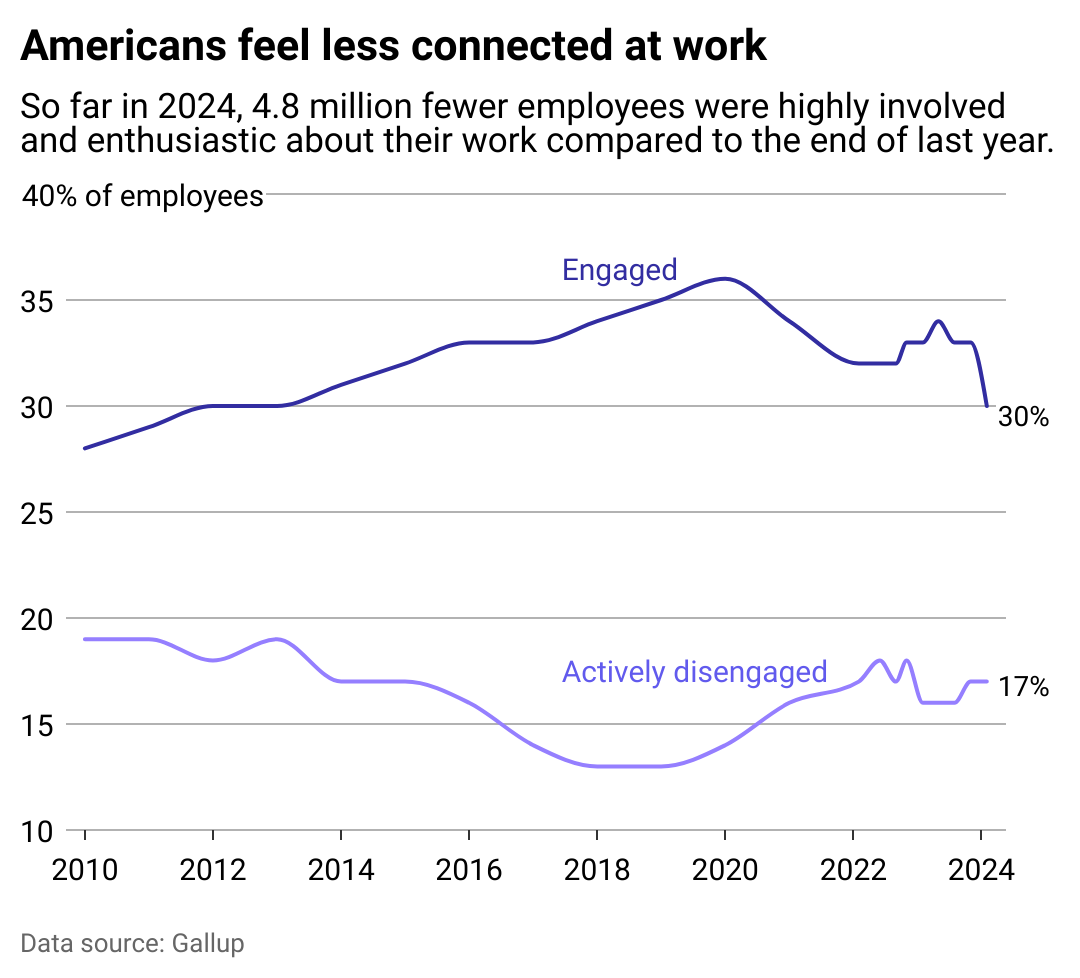
Remote workers feel less engaged at work. Here's how to fix that.
This story originally appeared on WorkTango and was produced and distributed in partnership with Stacker Studio.
Remote workers feel less engaged at work. Here's how to fix that.
Employee engagement is at an 11-year-low, according to the latest data from Gallup.
At the end of 2023, just 1 in 3 American employees reported being highly engaged. That number dropped by 3% of the total workforce in the first quarter of 2024, representing 4.8 million more workers joining the ranks of the disengaged.
While the rise of remote work may play a role, that's not the only factor. A 2022 report from tech company Cisco found hybrid work led to better work-life balance, well-being, and company culture.
In February 2023, 13.3% more people reported teleworking than in February 2020, according to the Bureau of Labor Statistics. Working remotely offers employees greater flexibility, autonomy, and cost savings; is more sustainable for the planet with less need for travel; and may even encourage greater productivity, according to the BLS. That said, working away from coworkers also severely limits one of the five necessary components of the Surgeon General's Framework for Workplace Mental Health and Well-Being: fostering social connection.
WorkTango compiled data from surveys, academic research, and other sources to find ways to increase engagement among remote employees.
Virtual communication is challenged by the absence of body language, vocal inflections, or even technical difficulties. Therefore, it's unsurprising that remote workers feel increasingly isolated. Half of workers who left their jobs attributed their resignation to their lack of a sense of belonging, according to McKinsey's 2022 Great Attrition, Great Attraction survey.
While leaders may cite this as a reason to push for a return to the office, nearly half (47%) of remote-working employees would rather find a new job, according to a 2023 Integrated Benefits Institute report. The answer, then, may lie in companies figuring out ways to increase employee engagement.

Driving forces behind the Great Resignation are alive and well
Employee engagement began dropping in 2020 when lockdown restrictions and the shift to remote work spurred workers to reevaluate their employment situations. Then, a short-lived surge in unemployment in the infancy of the COVID-19 pandemic quickly gave way to increased demand for labor. Combined with low unemployment rates, this sparked the "Great Resignation," a period between 2021 and 2023 that saw people leave their jobs in record numbers.
Over 50 million workers quit their jobs in 2022, according to data from the 2022 U.S. Job Openings and Labor Turnover Survey, breaking the all-time-high record set the previous year. A 2022 Pew Research Center survey found that "low pay, a lack of opportunities for advancement and feeling disrespected at work" drove the most resignations.
While the Great Resignation may have formally ended, the factors that inspired it are still abundant. Per the Gallup report, some of the least-engaged employees include those who have telework-friendly positions but are still required to report on-site. With many more remote roles available in the job marketplace, commuting to an office as an obligation—not a need—can be a major deterrent to job-seekers.
This dynamic underlies a broader, ongoing push for less restrictive working conditions, particularly since employers still face steep competition for talent. Even the U.S. government relaxed drug policies for federal employees to attract more talent.
Employee retention is generally preferable to replacement, though, and research shows that engaging workplaces can be cultivated from the top down.

How managers can help employees feel more engaged
Connecting with employees may be more difficult in a workplace without watercooler chat, but it is as important as ever. There are dozens of ways to create space for meaningful interactions among coworkers, including virtual team-building activities, coffee chats, and virtual happy hours. It's also essential to acknowledge employee achievements, milestones, and feedback to ensure they feel valued.
Almost 1 in 2 employers say they don't take action on employee feedback, according to a 2023 survey by WorkTango. Workers who feel their perspective is not valued are unlikely to speak up or bring supplemental skills to the table. Setting aside time to chat virtually with employees individually is a good start, but successful managers should follow through on the discussion to ensure employees know they've been heard.
Remote workplaces also suffer from reduced visibility: It's difficult to praise a job well done when it is miles away and unobserved. A Joblist study published in 2021 found that 7 in 10 (70.2%) employees who felt unseen also felt burnt out; those who did not feel invisible were more productive and engaged. Remote-working managers should be careful not to succumb to "proximity bias," or the tendency to overvalue workers in nearest proximity, while undervaluing those who are not physically present.
Happy employees also have a work-life balance, which can be harder to come by in a remote setting. Nearly 2 in 5 (40%) work-from-home employees reported missing the "clear boundaries" between their personal and work lives afforded by commutes and separate work-life spaces, according to a report published in 2022 by Jones Lang LaSalle. Managers should be careful not to use remote accessibility to forgo standard work boundaries. That means respecting nonwork hours and not requiring (or praising) more work time than initially agreed upon.
Ultimately, fostering engagement with remote workers comes down to respecting their contributions, attending to their need for connection, and both collecting and acting on employee feedback to improve the new remote and hybrid workplace environment.
Story editing by Nicole Caldwell. Copy editing by Paris Close. Photo selection by Lacy Kerrick.



